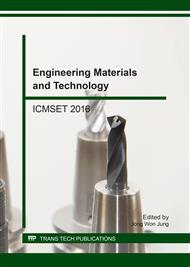[1]
A. Soleimani Dorcheh, R. N. Durham, M. C. Galetz. Corrosion behavior of stainless and low-chromium steels and IN625 in molten nitrate salts at 600°C. Sol. Energ. Mater. Sol. Cells. 144(3) (2016) 109–16.
DOI: 10.1016/j.solmat.2015.08.011
Google Scholar
[2]
A. Vesel, M. Mozetic, A. Drenik, Hauptman N, Balat-Pichelin M. High temperature oxidation of stainless steel AISI316L in air plasma. Appl. Surf. Sci. 255 (2008) 1759–1765.
DOI: 10.1016/j.apsusc.2008.06.017
Google Scholar
[3]
H. Buscail, S. El Messki, F. Riffard, S. Perrier, R. Cueff, E. Caudron, et al. Characterization of the oxides formed at 1000°C on the AISI 316L stainless steel - Role of molybdenum. Mater. Chem. Phys. 111 (2008) 491-496.
DOI: 10.1016/j.matchemphys.2008.04.054
Google Scholar
[4]
A. L. Marasco, D. J. Young. The oxidation of Iron-Chromium-Manganese alloys at 900°C. Oxid Met. 36(1-2) (1991) 157–174.
DOI: 10.1007/bf00938460
Google Scholar
[5]
J. Piekoszewski, B. Sartowska, Barlak M, Konarski P, Dąbrowski L, Starosta W, et al. Improvement of high temperature oxidation resistance of AISI 316L stainless steel by incorporation of Ce–La elements using intense pulsed plasma beams. Surf. Coat. Technol. 206 (2011).
DOI: 10.1016/j.surfcoat.2011.03.104
Google Scholar
[6]
A. Paúl, R. Sánchez, O. M. Montes, J. A. Odriozola. The role of silicon in the reactive-elements effect on the oxidation of conventional austenitic stainless steel. Oxid. Met. 67(1-2) (2007) 87–105.
DOI: 10.1007/s11085-006-9046-6
Google Scholar
[7]
A. M. Huntz, A. Reckmann, C. Haut, C. Sévérac, M. Herbst, F. C. T. Resende, et al. Oxidation of AISI 304 and AISI 439 stainless steels. Mater. Sci. Eng. A. 447(1-2) (2007) 266–276.
DOI: 10.1016/j.msea.2006.10.022
Google Scholar
[8]
T. D. Nguyen, J. Zhang, D. J. Young. Water vapour effects on corrosion of Fe-Cr and Fe-Cr-Ni alloys containing cerium and manganese in CO2 gas at 818°C. Corros. Sci. 89 (2014) 220–235.
DOI: 10.1016/j.corsci.2014.08.029
Google Scholar
[9]
H. F. Lopez, H. Mendoza, D. Angel. Long term high temperature oxidation resistance of a nanoceria coated 316 SS under dry air conditions. Mater. Chem. Phys. 146 (2014) 204–211.
DOI: 10.1016/j.matchemphys.2013.11.053
Google Scholar
[10]
Q. Jin, J. Li, Y. Xu, X. Xiao, W. Zhang, L. Jiang. High-temperature oxidation of duplex stainless steels S32101 and S32304 in air and simulated industrial reheating atmosphere. Corros. Sci. 52 (2010) 2846–2854.
DOI: 10.1016/j.corsci.2010.04.033
Google Scholar
[11]
E. Frutos, P. Adeva, J. L. González-Carrasco, P. Pérez. Oxidation behavior of AISI 316 steel coated by hot dipping in an Al-Si alloy. Surf. Coatings. Technol. 236 (2013) 188–199.
DOI: 10.1016/j.surfcoat.2013.09.046
Google Scholar
[12]
H. Buscail, S. El Messki, F. Riffard, S. Perrier, C. Issartel. Effect of pre-oxidation at 800 °C on the pitting corrosion resistance of the AISI 316L stainless steel. Oxid. Met. 75(1-2) (2011) 27–39.
DOI: 10.1007/s11085-010-9218-2
Google Scholar
[13]
K. A. Habib, M. S. Damra, J. J. Saura, I. Cervera, J. Bellés. Breakdown and evolution of the protective oxide scales of AISI 304 and AISI 316 stainless steels under high-temperature oxidation. Int. J. Corros. 2011 (2011).
DOI: 10.1155/2011/824676
Google Scholar
[14]
B. Pujilaksono, T. Jonsson, H. Heidari, M. Halvarsson, J. E. Svensson, L. G. Johansson. Oxidation of binary FeCr alloys (Fe-2. 25Cr, Fe-10Cr, Fe-18Cr and Fe-25Cr) in O 2 and in O 2 + H 2O environment at 600°C. Oxid. Met. 75(3-4) (2011) 183–207.
DOI: 10.1007/s11085-010-9229-z
Google Scholar
[15]
T. Jonsson, B. Pujilaksono, H. Heidari, F. Liu, J. E. Svensson, M. Halvarsson, et al. Oxidation of Fe-10Cr in O2 and in O2+H2O environment at 600°C: A microstructural investigation. Corros. Sci. 75 (2013) 326–336.
DOI: 10.1016/j.corsci.2013.06.016
Google Scholar
[16]
T. Jonsson, S. Karlsson, H. Hooshyar, M. Sattari, J. Liske, J. E. Svensson, et al. Oxidation After Breakdown of the Chromium-Rich Scale on Stainless Steels at High Temperature: Internal Oxidation. Oxid. Met. 85(5) (2016) 1–28.
DOI: 10.1007/s11085-016-9610-7
Google Scholar


